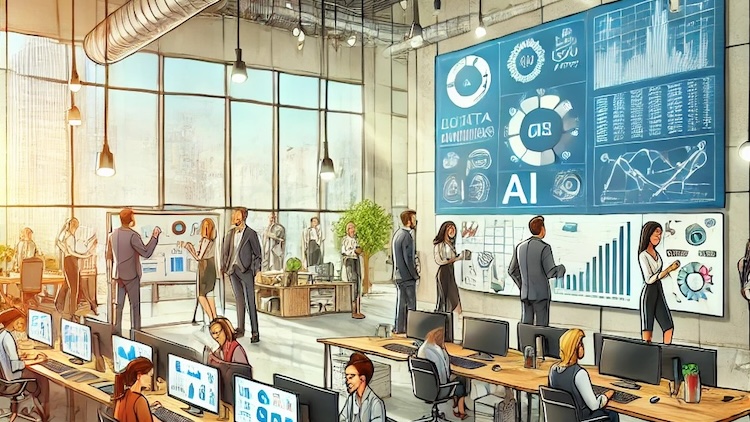
We need a different approach to improving skills for digital transformation, says Dr Sara Mehrabi, UK-based director at the international engineering firm Cowi and soon to be its vice-president for data analytics, business intelligence and AI. Here she talks about the challenges.
Before we jump into her thoughts about improving digital skills, Dr Mehrabi explains her role at Cowi. “Cowi (pronounced ‘covi’) is a Danish engineering company, with its roots in bridge engineering. In 94 years of existence, it’s grown from a Danish company to a Nordic company and a bit later into an international company with branches in the UK, North America, India, Lithuania, and Poland, among other locations.
“I am the director overseeing digital development across six Cowi UK offices, but have now been appointed to a new role as vice-president for data analytics, business intelligence and AI, starting in October. This will involve leading a team of digital specialists, in our continued efforts to leverage data and AI in driving innovation, enhancing operational efficiency and delivering transformative solutions for our clients.”
BIMplus: At Digital Construction Week, you talked about the challenges of nurturing talent, and giving people the environment to thrive…

“It’s not just about focusing on young talent – we need to look at upgrading the skills of the older generations of workers.”
Dr Sara Mehrabi If you look at the research on why our industry is lagging in terms of digital transformation, it’s not that we lack the tools and the technology, but rather that the skills to use them properly are lacking in the industry.
And this is not just about focusing on young talent – we need to look at upgrading the skills of the older generations of workers. They’re the ones with technical expertise gained over many years – millennials and Gen Z would need another decade of work before they get to that level of understanding of the problems, let alone applying solutions to those problems.
I think our focus should shift from simply pursuing the latest technologies and gadgets to actually using and leveraging the most relevant and beneficial ones. So, we need to work out how we bring people up to scratch with the most relevant and impactful technologies.
Part of that is, of course, attracting new talent. Millennials and Gen Z come with a lot more digital savviness, and they’re generally more comfortable navigating through digital platforms and environments.
But the way in which we learn has completely changed. It’s no longer a question of getting your degree and doing your training on the job, and then being all set up for a lifetime career.
Millennials are now likely to have to pivot four to seven times within their working lifetime, and work on completely different things. That requires fast learning periods, and learning fewer topics in a deeper, more targeted way, to allow that pivot to be made. And I think companies at this stage don’t really provide for these new ways of learning, although startups are more likely to adopt them.
So, we’re talking about short and flexible courses, rather than a traditional Bachelor’s or Master’s degree that takes somewhere between two to four years to complete.
You need to invest in skills that enable your staff to be able to provide and produce information and data-rich models that can enable robotic construction. That means you should probably send them to a short and targeted training that allows them to not just learn how to drive a specific software package, but to really understand the fundamentals of information exchange and information management. In recognition of such needs, organisations such as BSI and BRE offer short courses that address them.
At the moment, we aren’t adopting this approach to training on a large scale, but it’s what we should be doing. People need to learn the basics and understand the concepts in-depth. We also need to explain the reasons behind our methods. The new generation doesn’t just follow instructions blindly – they want to know why they’re working with a certain model, why specific data is needed, and how it will be used. This kind of transparency helps them stay engaged and understand the bigger picture.
What are your thoughts on attracting people into the industry?
“One of the things we need to do more often is to map the competencies that companies have now and then compare that against what the market needs or will need in the future.”
As mentioned earlier, much of our discussions focus on young talent. But we usually overlook the wealth of mature digital talent out there, like software engineers who have been around for decades. There aren’t many of them in the construction sector: they don’t find our work exciting enough! We need to change our approach to make careers in construction appealing and rewarding for digital talents like programmers and data analysts. It’s important to show that they can have exciting opportunities to contribute meaningfully and grow professionally within our industry.
One of the things we need to do more often is map the competencies that companies have now and compare that against what the market needs or will need in the future. Time and time again, as projects start, we see companies scrambling to recruit just about anyone to fill some positions.
ISO 19650, with its pre-appointment [pre-contract] mobilisation plan, puts a huge emphasis on capability and capacity assessment before signing a contract, which is very helpful. This all happens in the tender response phase where you look at an opportunity in a project brief. You then understand the exchange information requirements and assess what kinds of skills and experiences you need to deliver that successfully. It means that, before you have committed to a project or particular deliverable, you’ve made plans to put those skills in place.
What are you advocating that people should do to attract new digital people into the sector?
A company’s external image doesn’t always match its internal reality. Many companies do great things internally, but don’t project that outward. On the flip side, some companies have fantastic branding, but new recruits often find the reality disappointing once they join.
Companies have to project an attractive image, especially for young people, and then make sure that reality matches the promise. Recruiting with promises of strong support for growth and development is no good if new hires find out they need to navigate complex approval processes just to attend an upskilling course. It’s even more problematic if those in charge don’t relate to modern learning methods.
Squiggly career
Dr Mehrabi’s thinking is no doubt influenced by her own career path – “squiggly” as she describes it. “I’ve had quite a ‘squiggly’ career, with lots of different experiences, but at the same time, I think they’ve all been connected and related. I’ve been working for about 22 years, and always as an engineer, or within the engineering industry, but experiencing different flavours of engineering in a series of different roles. I started with water, moved into the mining industry and then switched into infrastructure after that.
“I started as a site engineer before taking on senior engineering roles and then moving into project management, leadership roles and digital development.”
She took her engineering degree in Tehran, followed by completing her Masters and PhD in Australia. About 10 years ago, she joined Cowi in the Middle East and moved to Qatar on the Doha Metro megaproject. Six years ago, Dr Mehrabi moved to the UK, and since then has completed an MBA.
What about remote working?
One of the more sensitive issues that we’ve all faced (not just our industry) post-pandemic is the topic of remote working versus being in the office. While most baby boomers and many Gen X managers push for people to be in the office more often, due to our own professional history and learning ways, millennials seem to be at a stage in their lives where the flexibility of remote working appeals more.
I know what I’m about to say will upset some, but we have to take a look at what’s on offer ‘now’ rather than ‘then’. Learning platforms like Coursera, Udemy, LinkedIn Learning, Codecademy, Khan Academy, EdX, Udacity, MasterClass and many more allow us to learn from some of the best teachers, instructors and professionals in the world.
Even though I have immense respect for the seniors I learned from, being able to learn from the best experts in the field, as we can now do, as opposed to learning from a ‘best at your office’, is an attractive option.
There’s definitely a mismatch between workforce generations, and while I don’t have a silver bullet, it’s obvious that we need to find a way to work together in a more inclusive and accommodating way. We need to respect the different preferences and needs of all generations within an organisation. There’s never going to be a one-size-fits-all approach to learning.
What developments in AI are you looking at?
One of my passions, which aligns well with my new role, is the application of AI to benefit people, which significantly influenced my MBA thesis on organisational psychology. At Cowi, we have a long track record of using AI for engineering solutions. But my goal in this new role is to deploy AI in operations and for people, positively impacting Cowi employees, customers and the communities we are active in.
I want to counter the pessimistic fears some engineers have about losing their jobs to AI. Engineering is obviously a highly rule-based and logical profession, so many worry that because AI is likely to outperform humans in calculations and design work with accuracy and speed, it will be the end of human engineers in the future. Focusing on AI’s positive aspects, I want to show its potential to enhance, rather than replace, human capabilities, because it’s what I really believe in.
AI can analyse and combine data in novel ways, helping us extract new insights we would never have seen otherwise. These kinds of explorations enable us to create a work environment that feeds into innovation and inclusivity. It also holds the promise of getting rid of many human biases, improving equity and diversity within organisations. The potential of AI to bring about these positive changes is really exciting. I think it’s high time we stop just talking about what AI can do and start making things happen. That’s why I’m so pumped to see what my next career step has in store.
Don’t miss out on BIM and digital construction news: sign up to receive the BIMplus newsletter.












